Improved rope runs with minimum changes, two-machine case study
Apr 23, 2019
Rope runs, tail drops and up transfers
Rope systems are designed to carry a "tail" of paper through sections of a paper machine to thread it prior to widening the sheet to full width. There are one or more points in the process where it is desirable to drop the tail and widen the sheet prior to threading up the next section. Such points (or stations) are referred to as "tail drops" or drop stations. These stations also provide a position in the process where the sheet can be broken down when problems occur in following sections.
On many machines, the only location where a sheet drop is provided (relative to rope systems) is at the last dryer in a section.
Since paper machine dryers are broken up into separate groups (or sections) for drive purposes, each section must have its own complete and independent rope system. When threading a machine, it is desirable to have the paper tail go through all dryer sections without having to be handled. Therefore, a means of interfacing adjacent rope systems has to be devised so that the tail is automatically passed from each rope section to the next. This interaction is known as "Automatic Transfer".
There are several ways that such a transfer can be designed. One of these involves tearing some of the tail off at each transfer. A second way is to pass the tail intact from one section to the next. Some machines were built when the state of the art was to tear the tail at each transfer. With this system, some rope sheaves at the transfer have large flanges on one side for the sole purpose of severing the tail. There are some poor features in this "tear-off" concept:
- Damage to the tail is an accepted part of the process. The nature of this damage was not always predictable.
- Shredded tails, or debris, is created by the tear-off.
To compound the problem, a machine may have "up transfers" between dryer sections. That is, the tail is transferred from one section to the next on up-runs of ropes (due to dryer drive gearing on the back side). The tail shreds created by the tear-off transfer are released into the upper hood where they become difficult to purge.
Case study: PM1 & PM2 problems with transfers and debris
At this mill, there were frequent and worsening issues with transfers from one rope run to the next. Some rope runs were old and originally designed for tear-off transfers. In addition, on PM2 there were up transfers between dryer sections. Pieces of tail were going up into the hood and falling down on the felt and conveyer on down to the wet end then down into the sheet run causing sheet breaks.
Transfers on both machines were improved with some simple modifications that permit transfer of tails intact from one section to the next, eliminating - or at least minimizing - creation of shreds.
Figures 1 throu 8 show the rope systems as they previously existed as well as after modifications were made to improve transfers. Figures 1 to 4 are for #1 machine. Figures 5 to 8 are transfers and areas of concern for #2 machine. (Note: With the machines in operation, it was impossible to access some locations, so final location of some of the new sheaves was determined at installation.)
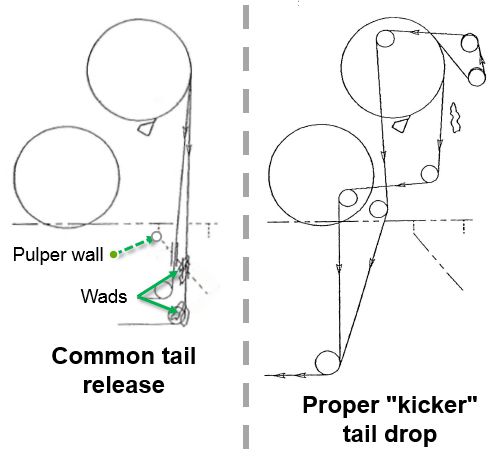
Proper kicker tail drop vs. common tail release
We addressed the problem of providing clean tail drops at last dryers. This involved the use of kicker sheaves on the opposite-the-tail side of each rope to knock, or kick, residual tail off the respective ropes to alleviate fouling of return runs. These kickers were provided as an essential ingredient of a clean transfer as well. Tail-drop rope sheave placement was determined at installation.
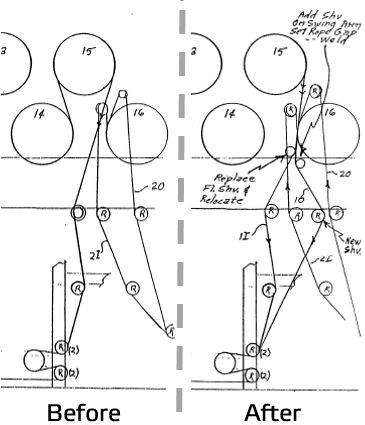
Figure 1 PM1 1st dryer section, before and after rebuild
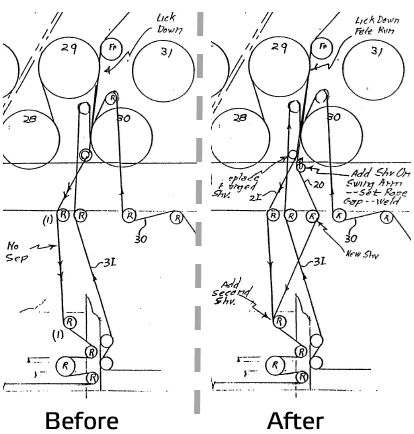
Figure 2 PM1 2nd dryer section, before and after rebuild
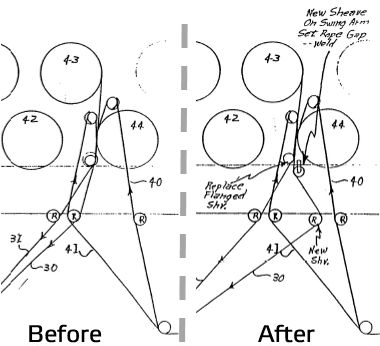
Figure 3 PM1 3rd dryer section, before and after rebuild
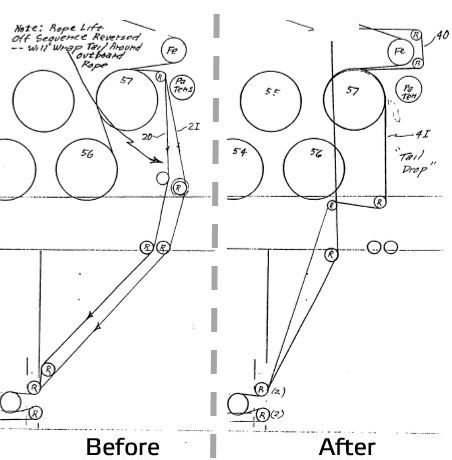
Figure 4 PM1 4th dryer section, before and after rebuild
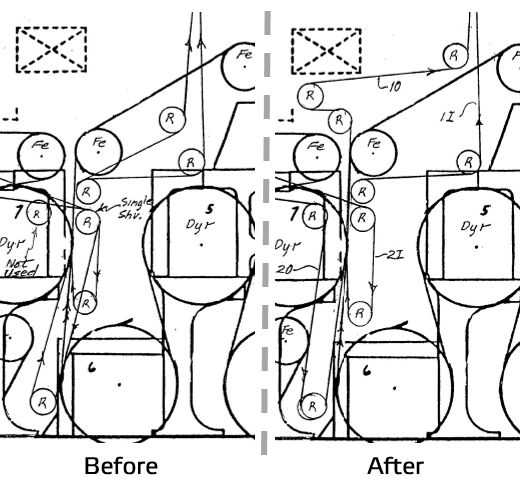
Figure 5 PM2 1st to 2nd dryer section transfer, before and after rebuild
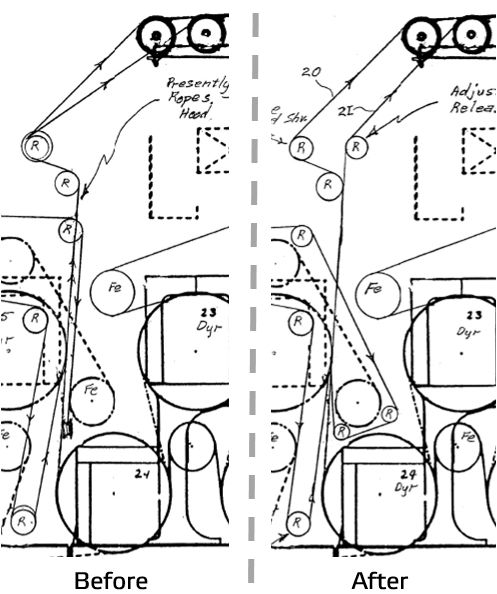
Figure 6 PM2 2nd to 3rd dryer section transfer, before and after rebuild
On #2 machine, some special problem areas were addressed. Ropes previously ran over paper tension rolls making them less effective in sensing paper tension. By changes in the rope runs, the ropes are now removed from the paper tension rolls eliminating this influence (Figures 7 & 8) In the old breaker stack area, we changed the transfer from 3rd to 4th section to be made at the first tension roll (Figure 7). All ropes are removed from the second tension roll so that it could accurately control paper tension in this draw.
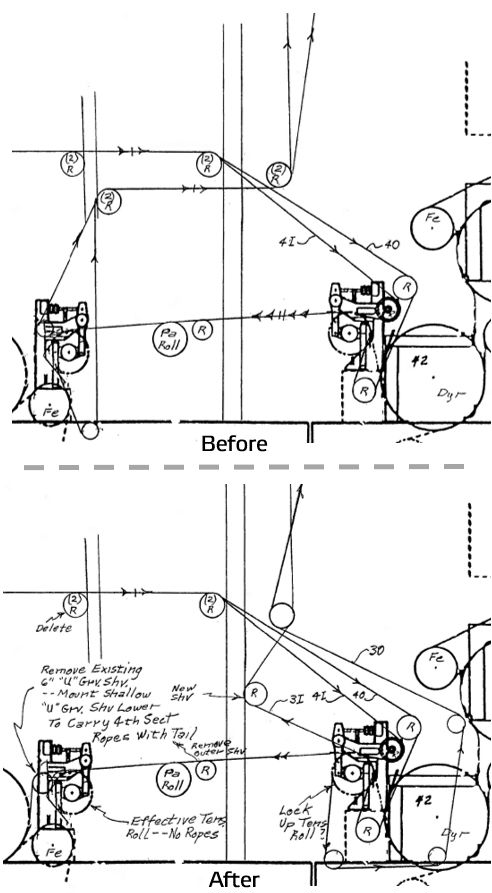
Figure 7 PM2 3rd to 4th dryer section transfer, before and after rebuild
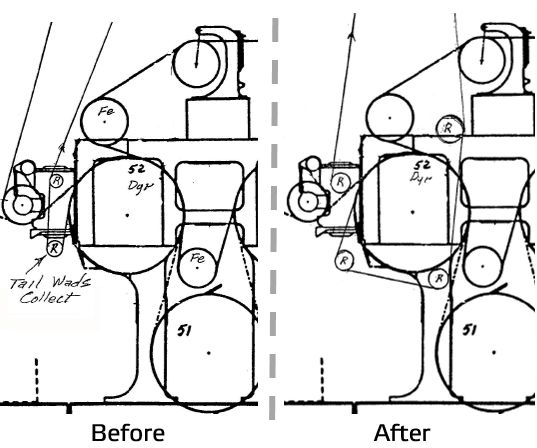
Figure 8 PM2 last dryer tail release, before and after rebuild
Changes to rope tension control cylinders
In connection with the above, all rope tension control air cylinders were being run in bottomed out condition. Such operation completely nullified rope tension control. Rope tension was set by wind-up on the boat winch. All control was lost and there was no forgiveness in the system. When a paper wad would go through a sheave nip, a wreck of the system could occur. Limit switches were existing for the bottom of each cylinder, and would trigger visual indication on the operator benchboard when a switch was engaged. We installed second limit switches, connected in parallel with the existing switch on each cylinder to indicate when the cylinders are stroked out.
We strongly recommended that the tension devices be operated as designed - somewhere near mid-stroke on the cylinder - so air cylinder pressure can control rope tension.
One of the advantages of air cylinder control of rope tensions is that the device lends itself to two-mode control of rope tensions. By addition of a few simple controls the mill can now have "RUN" tension (about 15 pounds) and "THREAD" tension (about 30 pounds). Such control of rope tension extends rope life considerably.
Unorun threading issues
In general, while unorun dryer sections have improved runnability considerably, they have also created some special problems for threading. To name a few:
- The "free tail" on the dryer felt runs ahead of the rope "carried-tail" and creates problems at the first transfer. This is due to the depth of rope grooves in dryers causing ropes to run slower than felts on dryer surfaces. This problem was alleviated by installing filler hoops (or rings) in existing dryer rope grooves to make them shallower.
- Also, as a result of the depth of dryer rope grooves, ropes and felts cross between each dryer. This together with difference in speed (item 1 above) causes a shear on the tail between ropes and felts. Increasing the distance between ropes and felt (guiding felt toward back) lessened the intensity of this shear.
- Many blow-boxes use edge jets to control air flow through dryer fabrics. These jets are intense enough to destroy paper tails or at least wrap them on the ropes so they cannot transfer. This is particularly true in wet end sections where the tail is weak. (Figure 9). Debris adjacent to the first section on #2 machine was a classic symptom of this problem. If the tail is not damaged, it can become wrapped around the ropes so that it cannot transfer. Therefore, we recommended threading the machine with blow box air shut off.
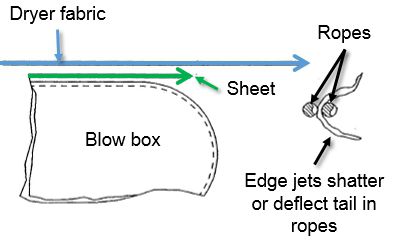
Figure 9 Blow box jet edge effect on paper tail
Rope geometry at transfers is very important. Off-going ropes should pass in close proximity of the dryer where on-going ropes nip. Whenever possible the ropes should separate in two planes. In the machine-direction, the first off rope should lift off the tail sandwiched between the ropes. If the wrong sequence is used, the tail can end up wrapping the other rope. In the cross-direction, the gap must be enough to release the tail. (Figure 10) On up-transfers, the gap geometry becomes very critical, if too little, the tail gets carried up into the hood, if too loose, the tail will fallout before a transfer can be made.
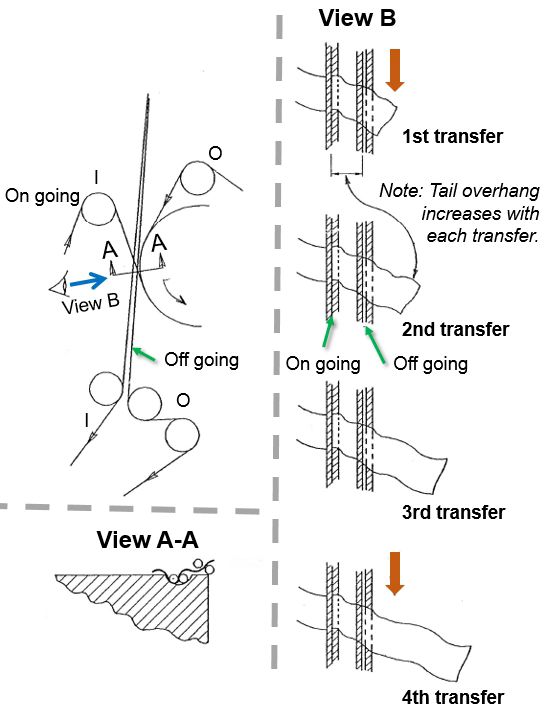
Figure 10 Mechanism of multiple transfers
Summary
The rope systems on both machines were made much more reliable by making a minimum of changes. Basically, Valmet changed the transfer philosophy from tear-off to tail-release. This resulted in less fouling of return runs, and on #2, less debris on the upper hood. If tail drops at last dryers can be worked out, more viable systems will result.
Some basic principles
- At-transfers, on-going ropes should always be inboard of off-going ropes.
- Off-going ropes must separate in the proper sequence to release the tail intact to on-going ropes.
- Whenever possible use kicker sheaves on opposite-tail-side of ropes after tail release at transfer or tail drop. These sheaves should kick any residual tail off the rope before the rope nips on a tail-side sheave.
- Use as large a sheave as possible in a given location. Less RPM results in better bearing life and also reduces internal wear in the rope.
- Use large (1-15/16") pin sheaves whenever possible. The larger pin provides much longer bearing life. Most pin brackets will accommodate these pins.
- Use only dynamically balanced cast-iron sheaves.
- Use shallow "U" groove sheaves on tail-carrying runs. Use deep "U" or "V" groove sheaves on return runs.
- Do not bottom-out pneumatic cylinders on rope tension devices. Have limit switches at each cylinder end.
For assistance with modernizing your rope runs, or converting your machine to ropeless threading, contact your Valmet representative.